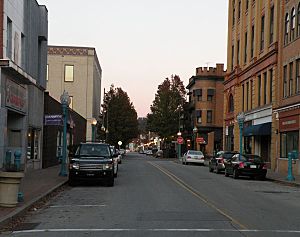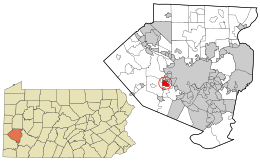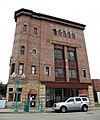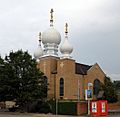Carnegie, Pennsylvania facts for kids
Quick facts for kids
Carnegie, Pennsylvania
|
|
|---|---|
|
Borough
|
|

East Main Street in 2011
|
|
| Etymology: Andrew Carnegie | |

Location in Allegheny County and the U.S. state of Pennsylvania.
|
|
| Country | United States |
| State | Pennsylvania |
| County | Allegheny |
| Incorporated | March 1, 1894 |
| Area | |
| • Total | 1.62 sq mi (4.20 km2) |
| • Land | 1.62 sq mi (4.20 km2) |
| • Water | 0.00 sq mi (0.00 km2) |
| Elevation | 833 ft (254 m) |
| Population
(2020)
|
|
| • Total | 8,134 |
| • Density | 5,017.89/sq mi (1,937.99/km2) |
| Time zone | UTC-5 (EST) |
| • Summer (DST) | UTC-4 (EDT) |
| ZIP code |
15106
|
| Area code(s) | 412 |
| FIPS code | 42-11336 |
| School District | Carlynton |
| Website | Borough of Carnegie |
Carnegie (/kɑːrˈneɪɡi/) is a small town, called a borough, in Allegheny County, Pennsylvania, United States. In 2020, about 8,134 people lived there. It is part of the larger Pittsburgh metropolitan area.
Contents
History of Carnegie
Carnegie was named after Andrew Carnegie, a famous businessman who gave money to build many libraries. The town officially became a borough on March 1, 1894. It was formed by joining two smaller towns, Chartiers and Mansfield. Later, a part of Robinson Township (now called Rosslyn Heights) also joined Carnegie.
Some of the neighborhoods in Carnegie include Rosslyn Heights, Cubbage Hill, and Library Hill. In the past, many areas around Carnegie were mined for coal. Big steel factories like Superior Steel and Union Electric Steel were major employers. Carnegie also had a busy train yard that connected to several railroads in the early 1900s.
In 1923, a large group of people from outside the town marched in Carnegie. Local residents stood up to them, and there was a conflict that resulted in injuries.
During the 1970s, Carnegie faced tough times when many large steel mills in and around Pittsburgh closed down. This caused economic problems for the town.
In 2004, Carnegie was badly flooded by Hurricane Ivan. Many businesses and churches in the downtown area were damaged or had to close. However, since 2014, Carnegie's Main Street has become lively again. Many new restaurants and small businesses have opened up.
Geography and Location
Carnegie is located at 40°24′25″N 80°5′12″W / 40.40694°N 80.08667°W. It is about 5 miles (8 kilometers) southwest of Pittsburgh. A stream called Chartiers Creek flows through the middle of the borough. Another stream, Campbells Run, joins Chartiers Creek in Carnegie.
The borough covers a total area of about 1.6 square miles (4.2 square kilometers), and all of it is land. The average height of Carnegie is 833 feet (254 meters) above sea level.
Neighboring Communities
Carnegie shares its borders with several other communities:
- To the north: Rosslyn Farms
- To the east, south, and southwest: Scott Township
- To the west: Collier Township
- To the northwest: Robinson Township
Population Changes
| Historical population | |||
|---|---|---|---|
| Census | Pop. | %± | |
| 1900 | 7,330 | — | |
| 1910 | 10,009 | 36.5% | |
| 1920 | 11,516 | 15.1% | |
| 1930 | 12,497 | 8.5% | |
| 1940 | 12,663 | 1.3% | |
| 1950 | 12,105 | −4.4% | |
| 1960 | 11,887 | −1.8% | |
| 1970 | 10,864 | −8.6% | |
| 1980 | 10,099 | −7.0% | |
| 1990 | 9,278 | −8.1% | |
| 2000 | 8,389 | −9.6% | |
| 2010 | 7,972 | −5.0% | |
| 2020 | 8,134 | 2.0% | |
| Sources: | |||
The population of Carnegie has changed over the years. In 1900, there were 7,330 people. The population grew steadily until 1940, when it reached its highest point with 12,663 residents. Since then, the population has slowly decreased. In 2020, the population was 8,134.
Community Life and Culture
Carnegie is a great place to walk around, with many interesting shops and restaurants on its Main Street. The town park offers lots of activities for kids and families. It has a dog park, a playground, tennis courts, a hockey rink, basketball courts, and baseball fields. There are also walking trails and the Pitcher Skate Park.
The Andrew Carnegie Free Library & Music Hall is a special place. It houses the Grand Army of the Republic Cpt. Thomas Espy Post, which is a historical group. It also hosts theater shows by Stage 62. Another theater group, Off the Wall Productions, is also based in Carnegie. They host the yearly Pittsburgh New Works Festival.
Carnegie is home to many different religious groups. There are several Christian churches, including Orthodox, Lutheran, Ukrainian Catholic, Methodist, Episcopal, Polish Catholic, and Roman Catholic Church churches. There is also a synagogue. More recently, an Attawheed Islamic Center opened in 2011, and an Indian Community Center opened in 2012.
The town also has many local clubs and organizations. These include groups like the VFW, FOE, and American Legion. These clubs help bring people together and support the community.
Education in Carnegie
Students in Carnegie attend schools within the Carlynton School District. There is an elementary school located right in the borough, making it easy for younger students to get to school.
Famous People from Carnegie
Carnegie has been home to several notable individuals who have achieved success in sports, politics, and the arts.
Athletes
- Mike Ditka: A member of the Pro Football Hall of Fame.
- Bernie Faloney: A member of the Canadian Football Hall of Fame.
- Patsy Flaherty: A Major League Baseball player who was friends with Honus Wagner.
- Skip Prosser: A former head coach for college basketball at Wake Forest University.
- Butts Wagner: A Major League Baseball player and the older brother of Honus Wagner.
- Honus Wagner: A legendary member of the Baseball Hall of Fame.
Politicians
- Ruggero J. Aldisert: A judge on the United States Court of Appeals.
- James H. Duff: Served as the governor of Pennsylvania from 1947 to 1951, and later as a U.S. Senate member from 1951 to 1957.
- James A. Wright: A member of the U.S. House of Representatives from 1941 to 1945.
Artists
- James Michael Newell: A mural painter who worked for the W.P.A.
- Brian Alfred: A painter, animator, and podcast host.
Gallery
-
The Andrew Carnegie Free Library, built in 1899.
See also
 In Spanish: Carnegie (Pensilvania) para niños
In Spanish: Carnegie (Pensilvania) para niños







